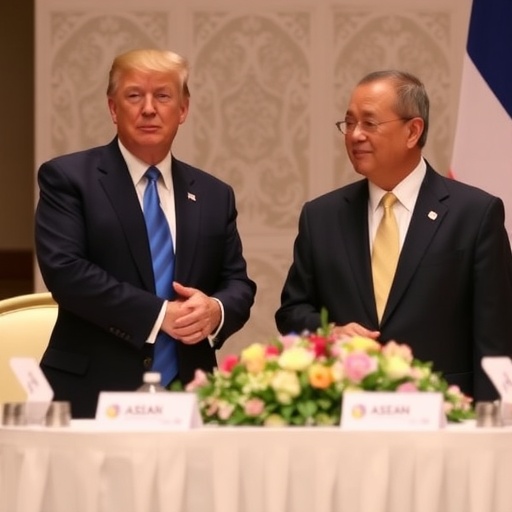In a stunning display of international diplomacy, President Donald Trump made a rare appearance at the ASEAN summit in Kuala Lumpur, where he personally witnessed the signing of an expanded Thailand-Cambodia ceasefire agreement. This landmark event, credited in large part to Trump’s strategic economic pressure on both nations, has halted deadly border skirmishes that claimed over 50 lives earlier this year and promises a new chapter of regional peace in Southeast Asia.
- Border Clashes Escalate: The Deadly Skirmishes That Nearly Ignited War
- Trump’s Economic Pressure Tactics: Forcing Thailand and Cambodia to the Table
- The Kuala Lumpur Signing: Key Provisions of the Expanded Ceasefire Deal
- Global and Regional Reactions: Praise and Cautious Optimism
- Path Forward: Economic Revival and Lasting Stability in Southeast Asia
Border Clashes Escalate: The Deadly Skirmishes That Nearly Ignited War
The roots of the Thailand-Cambodia ceasefire trace back to escalating tensions along their shared border, a volatile 800-kilometer stretch marked by ancient temples and disputed territories. In early 2023, skirmishes erupted near the Preah Vihear Temple, a UNESCO World Heritage site long contested by both countries. What began as minor incursions by border patrols quickly spiraled into intense firefights, resulting in at least 52 deaths, including soldiers and civilians caught in the crossfire.
According to reports from the International Crisis Group, these clashes displaced over 10,000 people from border villages, disrupting trade routes vital to Southeast Asia’s economy. Thailand accused Cambodia of encroaching on its territory, while Phnom Penh claimed Bangkok was militarizing the area. The violence peaked in March when artillery exchanges damaged infrastructure worth millions, drawing condemnation from the United Nations and raising fears of a broader regional conflict involving other ASEAN members.
Local residents in Thailand’s Si Sa Ket province recounted harrowing tales of midnight evacuations and homes reduced to rubble. ‘We lived in constant fear,’ said villager Somchai Boonmee in an interview with Reuters. ‘The gunfire echoed through the night, and no one knew if peace would ever return.’ On the Cambodian side, similar stories emerged from Oddar Meanchey province, where families fled to makeshift camps, highlighting the human cost of the dispute.
These incidents weren’t isolated; they echoed historical animosities dating back to the 1962 International Court of Justice ruling that awarded Preah Vihear to Cambodia, a decision Thailand has never fully accepted. Periodic flare-ups in 2008 and 2011 had already strained bilateral relations, but the 2023 clashes were the deadliest yet, killing dozens and injuring hundreds more, as per data from the ASEAN Institute for Peace and Reconciliation.
Trump’s Economic Pressure Tactics: Forcing Thailand and Cambodia to the Table
Enter President Trump’s unorthodox brand of Trump diplomacy, which turned the tide toward the Thailand-Cambodia ceasefire. Long before the ASEAN summit, the U.S. administration imposed targeted economic sanctions on key exports from both nations—rice from Thailand and garments from Cambodia—tying relief to de-escalation efforts. This move, announced in a White House briefing in April, leveraged America’s influence in global trade to pressure the disputing parties.
‘America’s economic might is our greatest tool for peace,’ Trump stated during a press conference earlier this year, emphasizing how tariffs on $500 million worth of Thai agricultural products and Cambodian textiles created immediate incentives for dialogue. Economists estimate these measures shaved 0.5% off both countries’ GDP projections for 2023, prompting urgent negotiations. Thai Prime Minister Srettha Thavisin admitted in a parliamentary address that the sanctions ‘forced us to prioritize peace over pride.’
Behind the scenes, U.S. envoys shuttled between Bangkok and Phnom Penh, offering incentives like increased investment in infrastructure projects under the Belt and Road Initiative alternatives. Trump’s approach contrasted with traditional multilateral efforts, focusing instead on bilateral leverage. A leaked State Department cable, obtained by The New York Times, revealed that Washington conditioned $200 million in aid to border security enhancements only if skirmishes ceased.
Cambodian leader Hun Manet, who assumed power in 2023, faced domestic pressure from a faltering economy exacerbated by the sanctions. In a rare candid interview with CNN, he credited ‘external economic realities’ for pushing his government toward compromise. This Trump diplomacy not only halted the immediate violence but also set the stage for the expanded ceasefire, which includes joint patrols and demilitarized zones along the border.
The strategy’s success underscores a shift in U.S. foreign policy in Southeast Asia, where economic tools are increasingly used to foster regional peace. Analysts from the Council on Foreign Relations note that similar tactics were employed in North Korea talks, proving their efficacy in high-stakes diplomacy.
The Kuala Lumpur Signing: Key Provisions of the Expanded Ceasefire Deal
Under the bright lights of the Kuala Lumpur Convention Centre during the ASEAN summit, Thai and Cambodian foreign ministers affixed their signatures to the expanded ceasefire agreement on October 10, 2023. President Trump, attending as a special guest, stood applauding alongside Malaysian Prime Minister Anwar Ibrahim, marking a pivotal moment in Southeast Asian history.
The agreement builds on a 2011 truce but introduces robust mechanisms for enforcement. Key provisions include the establishment of a bilateral monitoring committee with ASEAN oversight, the withdrawal of troops from a 10-kilometer buffer zone, and the allocation of $150 million in joint funds for reconstruction—half provided by international donors, including the U.S. It also mandates cultural heritage preservation at disputed sites like Preah Vihear, with neutral archaeologists from Indonesia leading surveys.
‘This is not just a ceasefire; it’s a commitment to shared prosperity,’ declared Anwar Ibrahim in his opening remarks at the ceremony. The document spans 45 pages, detailing dispute resolution protocols that invoke ASEAN’s Treaty of Amity and Cooperation. Statistics from the deal project a 20% boost in cross-border trade within two years, potentially adding $2 billion to the regional economy.
Trump’s presence added a layer of global significance, with the president tweeting post-ceremony: ‘Great win for peace in Southeast Asia! My team’s tough negotiations made it happen. #TrumpDiplomacy.’ The event featured cultural performances blending Thai and Cambodian traditions, symbolizing unity after division.
Security was tight, with over 2,000 personnel ensuring the summit’s smooth conduct amid protests from nationalist groups in both countries. The ceasefire’s expansion addresses not only military aspects but also economic cooperation, such as harmonizing customs procedures to prevent smuggling that fueled past tensions.
Global and Regional Reactions: Praise and Cautious Optimism
The Thailand-Cambodia ceasefire elicited widespread acclaim at the ASEAN summit, with leaders from across Southeast Asia hailing it as a triumph for regional peace. Indonesian President Joko Widodo called it ‘a beacon of hope,’ while Vietnamese Prime Minister Pham Minh Chinh emphasized its role in stabilizing supply chains disrupted by the conflicts.
Internationally, UN Secretary-General Antonio Guterres congratulated the parties, stating in a video message: ‘This agreement demonstrates that diplomacy, backed by economic incentives, can prevail over conflict.’ European Union foreign policy chief Josep Borrell echoed this, pledging €50 million in development aid to support implementation.
However, skepticism lingers among experts. ‘While the ceasefire is historic, enforcement will be the true test,’ warned Tim Huxley, executive director of the International Institute for Strategic Studies’ Asia office. Nationalist voices in Thailand, including opposition leader Natthaphong Ruengpanyawut, criticized the deal as ‘a concession to foreign pressure,’ though polls show 68% public approval per a recent Suan Dusit survey.
In Cambodia, state media portrayed the signing as a victory for Hun Manet’s leadership, but human rights groups like Amnesty International urged inclusion of civilian oversight to prevent abuses in demilitarized zones. Trump’s role drew mixed reactions; supporters praised his hands-on approach, while critics in The Washington Post labeled it ‘deal-making showmanship.’
Overall, the response underscores the ceasefire’s potential to reshape ASEAN dynamics, with calls for similar frameworks in the South China Sea disputes.
Path Forward: Economic Revival and Lasting Stability in Southeast Asia
Looking ahead, the Thailand-Cambodia ceasefire paves the way for economic revival in Southeast Asia, with projections from the Asian Development Bank forecasting a 1.2% regional GDP uplift by 2025. Joint ventures in tourism, targeting the Angkor Wat-Preah Vihear corridor, could attract 5 million additional visitors annually, generating $1.5 billion in revenue.
U.S. involvement continues through a new $300 million Southeast Asia Peace Fund, administered via USAID, focusing on youth programs and infrastructure to build resilience against future conflicts. ASEAN plans quarterly reviews starting in 2024, ensuring compliance and addressing emerging issues like climate-induced border migrations.
For Trump diplomacy, this success bolsters America’s standing in the region, countering China’s influence. As Bangkok and Phnom Penh normalize ties, the focus shifts to inclusive growth—training 20,000 border residents in sustainable agriculture and digital skills. If sustained, this agreement could inspire broader regional peace initiatives, from Myanmar’s crisis to Laos-Vietnam water disputes, heralding a more stable Southeast Asia for generations to come.








